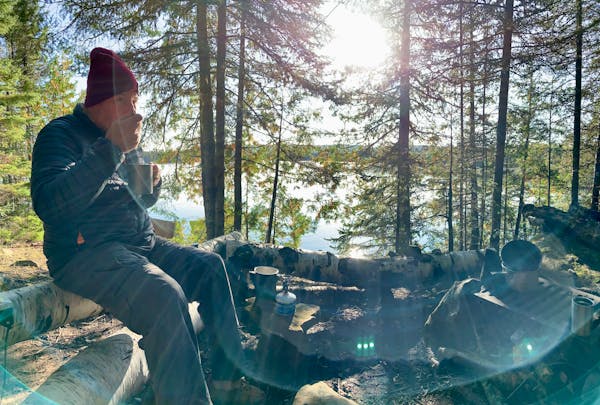A roadside billboard in northern Minnesota has caused a controversy by suggesting that legalized hunting of wolves could save tens of thousands of baby deer.
The advertisement, installed last month by a local chapter of the Minnesota Deer Hunters Association (MDHA),stands despite being debunked by a University of Minnesota wolf research group. Now MDHA's executive board will meet Saturday to possibly rein in misinformed messaging campaigns.
The billboard along Hwy. 53 south of Eveleth shows a spotted deer fawn beside a block-lettered message saying: "Wolves devour over 54,000 fawns a year in Minnesota.'' A bold-faced tagline across the bottom reads, "PAID FOR BY THE MINNESOTA DEER HUNTERS ASSOCIATION – STURGEON RIVER CHAPTER.''
MDHA Executive Director Jared Mazurek said the chapter's billboard isn't backed by peer-reviewed science and has sparked an internal discussion about the conservation group's ''public outreach'' procedures. Mazurek said the Sturgeon River chapter's billboard campaign, slated to last three months, will be "a big agenda item'' at Saturday's regularly scheduled meeting of the MDHA's executive board in Grand Rapids.
"The billboard was done entirely by the chapter,'' Mazurek said. "It was not approved by the MDHA as an organization.''
Several phone messages left this week for Sturgeon River Chapter President Greg Baty were not returned by him. Two other chapter leaders were on hunting trips outside Minnesota and not available for comment.
Implied in the billboard, Mazurek said, is the message that Minnesota needs active wolf management, including hunting and trapping. He said MDHA agrees "100 percent'' that a hunting season is needed to reduce an overpopulation of wolves in the state. But the stance is best communicated in alignment with sound science, not emotion, he said.
Boatload of studies
The billboard's literal and figurative messages have been challenged on Instagram, X (formerly Twitter), and Facebook by the Voyageurs Wolf Project. Of course, wolves eat baby deer, the group says. But fawns also fall prey to coyotes and black bears. Moreover, others die every year from viral disease, birth defects, low birth weight and emaciation.
Bottom line, according to studies cited by Voyageurs Wolf Project leader Tom Gable getting rid of wolves in Minnesota would not improve fawn survival.
"There's a boatload of studies on deer fawn survival,'' Gable said. "This idea that wolves are the biggest issue is frankly kind of ridiculous based on evidence that exists.''
He said fawn survival is 41% in forested places. In wolf regions, the percentages range from 45% to 49%. "There's higher survival in our wolf range than the continental average,'' Gable said.
Gable noted a fawn survival study from Delaware, conducted in an area with no predators. The survival rate of deer fawns was 45%, he said. "Some animals are doomed to die … that certainly seems to be the case with deer fawns,'' Gable said.
The wolf project has been studying gray wolves in the greater Voyageurs National Park ecosystem for the past nine years and intends to continue, indefinitely. Gable said that if it weren't for wolves, Minnesota would have more coyotes, a predator species that occurs in higher densities than wolves. He added that some research in the Upper Peninsula of Michigan supports the claim that individual coyotes kill fewer fawns than individual wolves.
As for the billboard's claim that wolves devour 54,000 fawns a year, Gable said he hasn't seen any data to support it. Based on the Voyageurs Wolf Project's limited sampling, fawn predation by wolves varies considerably from year to year. That was the case in three of the past four summers, when a small number of wolves in the Voyageurs study area were monitored for fawn predation. Studied wolves ate an average of 20 fawns one year and as few as an average of six in another year.
The official population estimate of Minnesota wolves is around 2,700. If each wolf ate 20 fawns apiece in one year, it would equal 54,000 deaths. But Gable said it's highly unlikely that every wolf eats 19 or 20 fawns each year. Predation varies from year to year and from region to region based on food availability, variations in the weather and other possible factors.
"The point from their perspective is there are too many wolves … we need to kill wolves and manage them to save deer fawns,'' Gable said.
Amid the billboard kerfuffle, some critics of the Voyageurs Wolf Project have said on social media that the group is a public relations agency for wolves. The critics also have said that the group is an anti-hunting organization that is secretly trying to protect the animals. But Gable said his group's critique is not a statement for or against wolf hunting. Previously, the wolf project has had positive interactions with MDHA's Sturgeon River chapter, Gable said. In fact, the chapter once donated $2,500 to support his group's work, he said.
"We try our absolute best to stick to what can be determined/understood objectively and scientifically, and leave the larger, more complicated discussions about wolves and society's values to others,'' Gable wrote in a social media post.
Hunting wolves in Minnesota is prohibited by ruling of a federal judge in 2022. Previously, when the animals were delisted from the federal Endangered Species Act list, the Minnesota DNR allowed hunting and trapping of wolves in 2012, 2013 and 2014.
On a related matter, Mazurek said the MDHA isn't backing down on its decision earlier this year to drop support for the governor's deer hunting opener. The deer hunters group said their protest was due to Gov. Tim Walz's "continued attempts to ban wolf hunting and [support of] anti-gun legislation.''

Twins open homestand with loss to Blue Jays as Ryan Jeffers ejected after critical call

Federal judge approves $2.8B settlement, paving way for US colleges to pay athletes millions

United South Central wins Class 1A softball title with overpowering pitching

St. Cloud Cathedral endures a tense start, defeats Hawley for Class 2A softball state title

